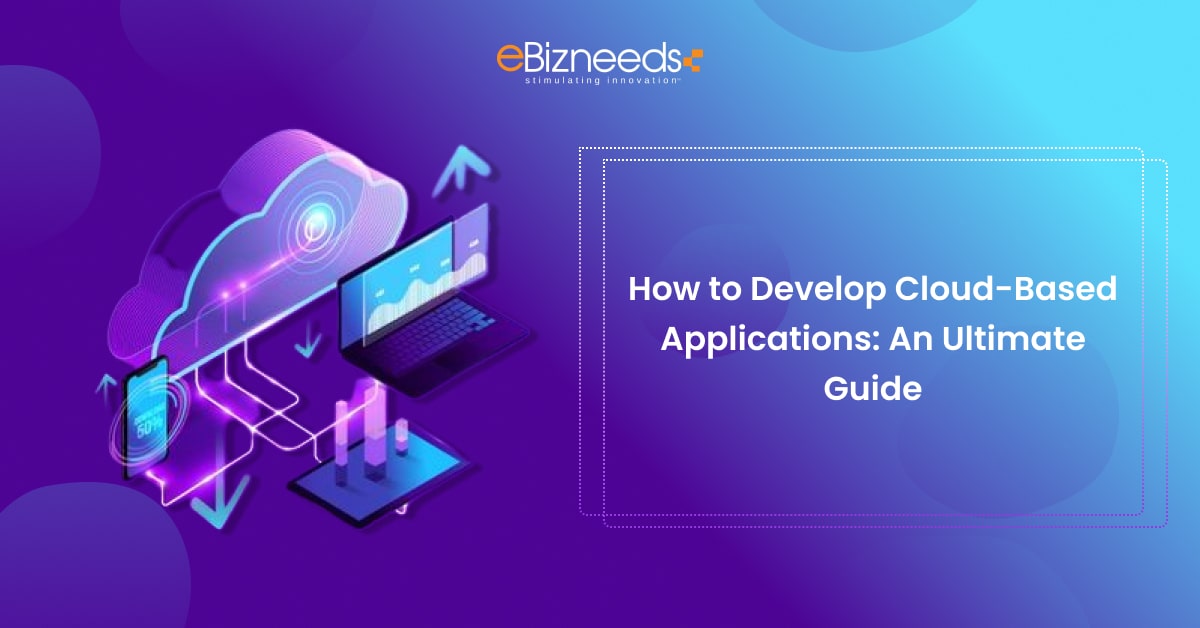Last updated on September 3rd, 2024 at 04:00 am
The number of mobile apps moving to the cloud is growing very quickly. Businesses all over the world use cloud computing for many different reasons.
One of the best things about cloud computing is that it has helped companies to save money on infrastructure and maintenance costs. It also ensures that resources are available at all times and places.
We made this guide to help you learn how to develop cloud-based applications. But before that, we will discuss what cloud-based applications are all about.
What is a Cloud-based Application?
A cloud-based application is a software application that runs on a cloud software application development platform and is accessed over the Internet. Cloud-based applications do not need to be installed or run on the user’s computer or server and are hosted and maintained by a cloud service provider.
But, users need to access cloud-based applications through a web browser or an app, and the cloud service provider manages the underlying infrastructure, including servers, storage, and network connectivity.
Cloud-based applications are designed to be scalable, flexible, and accessible, allowing users to use the software they need from anywhere with an internet connection. The cloud service provider can also update and maintain cloud-based apps, giving users access to the newest features and security updates.



Examples of cloud-based applications include customer relationship management (CRM) software, project management tools, email and productivity apps.
Cloud-based applications provide businesses and individuals with a cost-effective and flexible way to access the software they need without the need for expensive hardware and software investments.
Cloud App Market Statistics
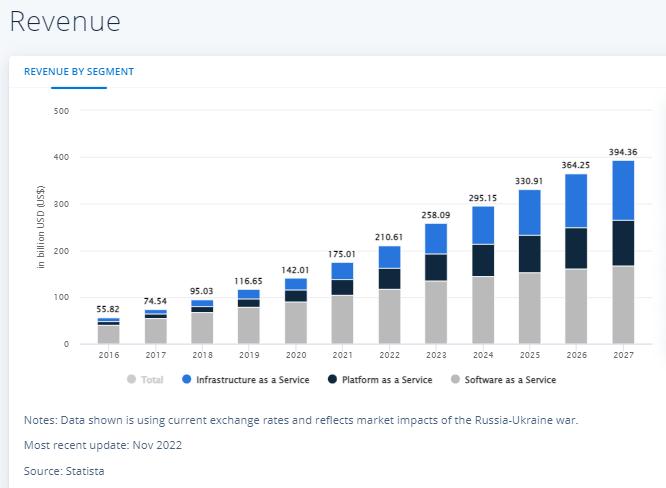


Source: Statista
- The public cloud market is expected to bring in $258.10bn in revenue in 2023.
- Revenue is also estimated to demonstrate an annual growth rate of 11.18%, resulting in a market volume of $394.40bn by 2027.
- The largest market segment is a software as a service, with an estimated market volume of $135.10 billion in 2023.
- In global comparison, most revenue would be generated in the US ($258.10bn in 2023).
- The average spend per workforce in the public cloud market is estimated to be $1.53k in 2023.
The above trends show that developing cloud-based applications is an excellent opportunity for you to make money.
Types of Cloud Computing
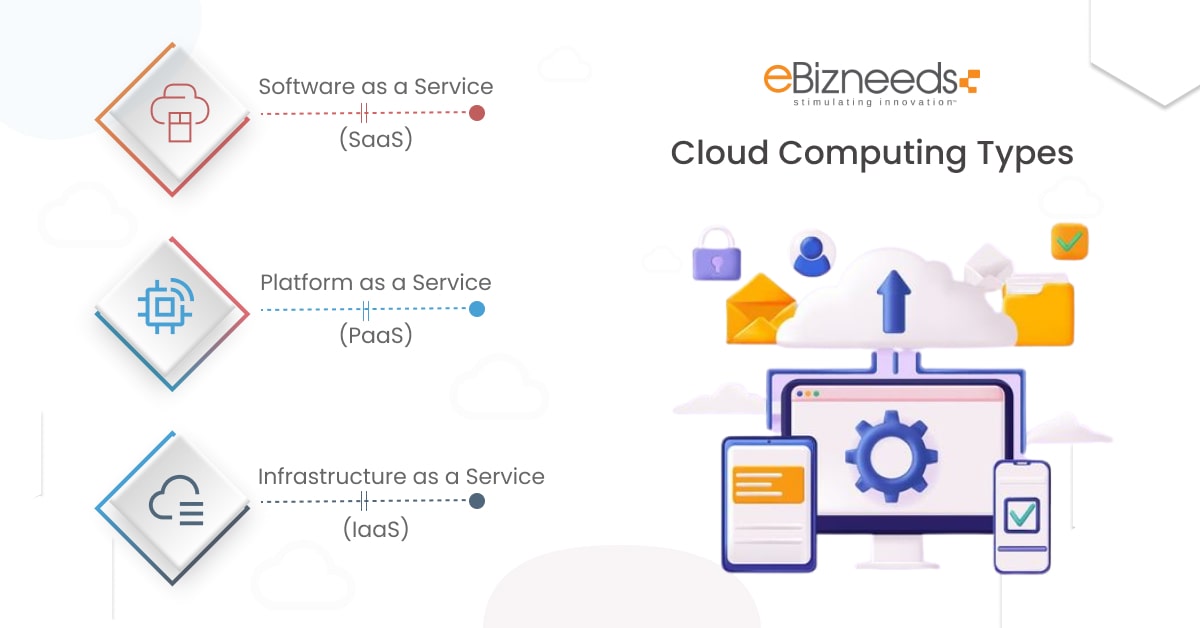


Cloud computing considers different services and resources that third parties run, such as data servers, storage, and databases.
The third-party permits the use of the computers and their infrastructure in free or paid. You can also use the resources, services, and space without having concern about maintaining the infrastructure.
Here, we will discuss some kinds of cloud-based solutions:
Software As a Service (SaaS)
This cloud computing service offers customers access to software applications over the Internet.
- SaaS avoids the customer’s need to run and install the software applications on their servers or computers.
- Instead, customers can access the software they require through a web app or browser, with the software and its fundamental infrastructure being handled and maintained by the cloud service provider.
- SaaS apps can be implemented for larger tasks, including email, customer relationship management, accounting, project management, and more.
- With SaaS, customers can access the software they need without the upfront costs and ongoing maintenance costs associated with traditional software.
- Additionally, cloud service providers often update and maintain SaaS apps, providing customers with access to the latest features and security updates.
- SaaS provides businesses and individuals with a flexible and cost-effective way to access the software they need without the need for costly hardware and software investments.
Examples of SaaS applications include Salesforce, Google Workspace, and Microsoft 365.
Platform As a Service (PaaS)
This is a kind of cloud computing service that offers customers a platform to develop, run, and manage apps and services.
- PaaS typically includes the underlying infrastructure, middleware, and development tools required to build and run applications, eliminating the need for customers to invest in and manage their hardware and software.
- Developers can focus on developing and deploying their apps while the cloud service provider deals with the underlying maintenance and infrastructure.
- PaaS typically includes tools and services such as development frameworks, databases, storage, and middleware that can be used to build, test, and deploy applications without the customer’s worry about the underlying infrastructure.
- PaaS provides customers with a cost-effective and scalable way to build, deploy, and manage applications, making it an attractive option for small and large businesses.
Examples of PaaS providers include Microsoft Azure, Google App Engine, and Heroku.
Infrastructure As a Service (IaaS)
IaaS is a cloud computing service that offers customers virtualized computing resources over the Internet.
- It provides virtualized computing infrastructure, including servers, storage, and network connectivity, that can host and run applications, store data, and provide network services.
- With IaaS, customers do not need to invest in and maintain their physical infrastructure but instead can rent computing resources on demand from a cloud service provider.
- This provides businesses with a flexible and scalable way to access computing resources without the capital expense and ongoing maintenance costs of owning and managing physical hardware.
There are specific examples of IaaS providers, such as Google Cloud Platform, Amazon Web Services (AWS), and Microsoft Azure.
Benefits of Using Cloud-Based Solutions
Cloud-based solutions offer a multitude of benefits to businesses and individuals alike. Some of the key benefits of developing cloud-based applications are:
Cost Savings
Cloud solutions are usually offered on a pay-per-use or subscription-based model, eliminating businesses’ need to invest in expensive hardware and software. This can result in significant cost savings for businesses.
Scalability
Cloud solutions could be easily scaled up or down according to changing business needs. This makes it possible for businesses to add or remove resources as needed without investing in new hardware.
Accessibility
You can access the cloud solution from anywhere with an internet connection. It makes it possible for workforces to work from anywhere at any time, increasing flexibility and productivity.
Security
You can also invest heavily in security measures to safeguard customer data. This includes encryption, secure data centres, and backup and recovery processes.
Collaboration
Cloud-based solutions often have built-in collaboration features, making it easier for teams to work on projects and access shared data and files.
Disaster Recovery
Cloud solutions include automatic backups and disaster recovery, which can help businesses avoid losing data because of broken hardware or other problems.
Environmentally Friendly
Cloud computing can help you reduce energy consumption and carbon emissions because resources are shared and not duplicated across multiple systems.
Automation
Cloud solutions can automate many tasks, like software updates, backups, and security scans, so that IT staff can work on more strategic tasks.
Integration
You can also connect to a broader range of other tools and systems that make it possible to streamline workflows and improve efficiency.
Competitive Edge and Sustainability
Cloud services can also be combined with AI technologies, such as chatbots and virtual assistants, to provide audiences with a personalized customer experience. By utilizing the developed AI communication on the cloud, the bank managed 50% of customer requests.
It results in reducing workforce costs by 20%. It is a massive competitive advantage for modern companies with longer-term sustainability objectives.
Mobility and Insight
The cloud app platform gives the company that makes mobile apps access to data from all of the team’s devices and systems. It also sends updates to the company. So, instead of hosting forms, companies are putting their money into cloud services to keep their employees happy and engaged.
Cloud-native app development supports personalized customer data insights to boost the data access experience and speed.
A Varied Range of Solutions
Cloud-based solutions aid in achieving higher business success by providing a range of services and resources for the business model. The cloud computing platform is used for everything from ERP to CRM solutions.
Features to Consider When Developing Cloud Based Application
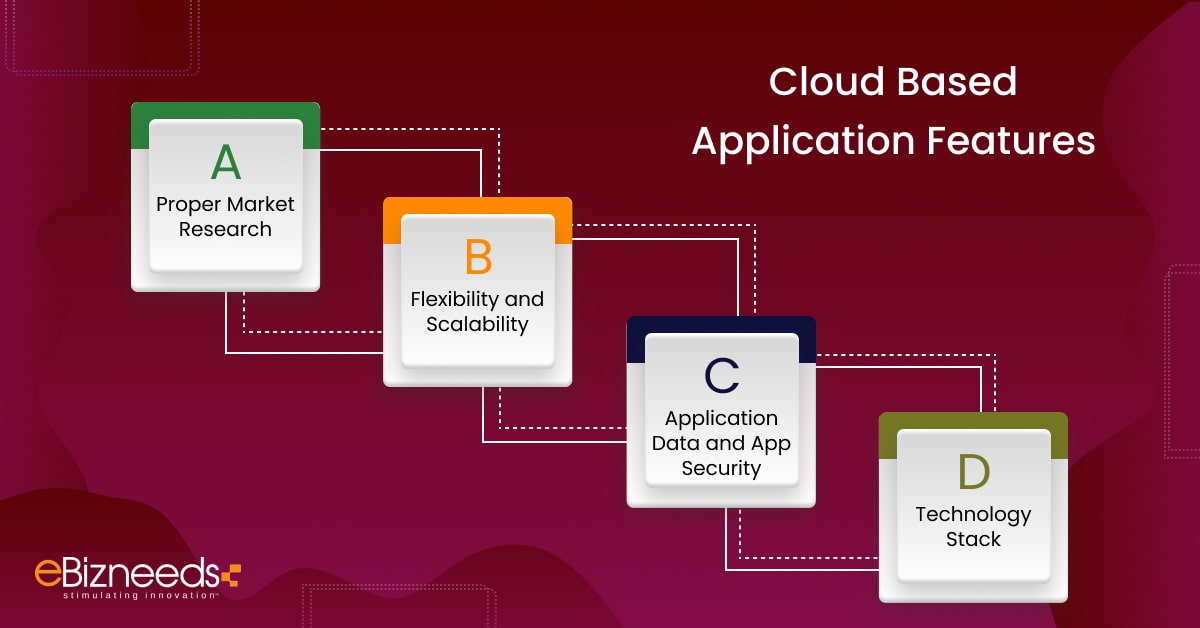


The cloud can do miracles for your organization if used the right way. Considering the benefits and preparing an objective before developing a cloud-based app is crucial.
The following are some features to consider when developing cloud-based applications:
Proper Market Research
Conducting marketing research is a must-have feature before initiating the development of your cloud-based app. It’s important to know what’s essential to the people you’re trying to reach, and your solution should be made to solve those problems.
Flexibility and Scalability
One of their most valued and important features is their ample space for scalability and flexibility. It ensures safe data storage that can be expanded according to convenience.
Application Data and App Security
When the storage aspect of the cloud is a winner, data security is always an issue. While investing in cloud-based application development, you should prioritize data and app security by building a code-based design for higher security.
Define Your App Technology Stack
When choosing a cloud-based application architecture, you should also talk to experts about the technology stack that will meet your cloud-based application development needs. After assessing your business requirements, they will recommend possible solutions.
In conclusion, cloud-based solutions offer a range of benefits, including cost savings, scalability, accessibility, security, collaboration, disaster recovery, environmental sustainability, automation, and integration.
By using cloud computing’s benefits, businesses can improve their operations, become more competitive, and better meet their customers’ needs.
Things to Consider While Developing Cloud-based Applications
It would help if you also discussed how developing cloud-based applications could expand. There are many good things about the cloud, but cloud hosting does cost money. When building the cloud platform, the most important things to do are reduce the size of user requests and optimize the data size.
Let’s check out what things should be considered before developing cloud-based applications.
Learn About the Various Types of Cloud Platforms
It would help if you worked with developers who know about cloud platforms to get these benefits from cloud-based apps. It fits well with what you need for your business.
Agile Approach
With an agile approach, you can work better with your programmers, developers, data architects, and QA manager to speed up development. Because of this, eBizneeds makes sure that the client is involved in every step of app development.
How to Develop Cloud-based Applications
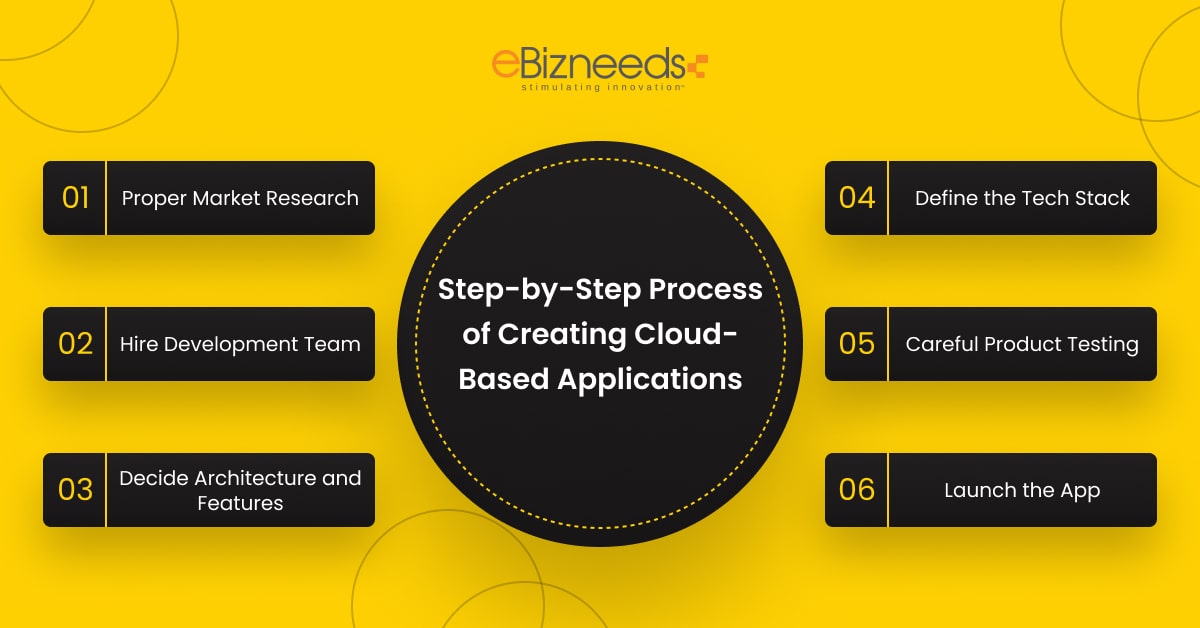


The development of cloud apps differs more from that of web and mobile apps since cloud solutions need knowledge of how to be built on a particular service provider.
Based on what we know, we think you should use AWS. It is one of the good options on the market right now. It is small and has many essential features and tools for building cloud apps.
Any digital product that needs to be built requires money and time, and cloud-based solutions are no different. You must understand your consumers well enough to identify their challenges and how your solution may address them before you begin the cloud development process. It’s also a big part of getting ahead in a competitive market.
Let’s go over the step-by-step process of creating cloud-based applications.
Step 1: Proper Market Research
To finish the job, you must do enough thorough market research to understand the customer’s pain. It will help you develop a good solution that your customers will like.
Step 2: Hire a Development Team
You require a team of knowledgeable, intelligent individuals to get data about how to create a cloud application. It would be best if you thought about where to find cloud app developers to hire.
You can hire mobile app developers, software engineer, freelance developer services, or an outsourcing firm, among other things.
Step 3: Decide Architecture and Features
There are many parts to developing an app, such as the service and architecture models. You should choose them carefully because your choices will affect how the application works. It advises speaking with professionals for the best outcomes.
Step 4: Define the Tech Stack
It would be best to ask the expert what technological stack you need to employ for cloud-based application development when you speak with them about creating the architecture of cloud-based applications.
Experts have a lot of experience, and after looking at your features, needs, and design, they will tell you the best solution. It would be best if you always thought about how scalable an app is because that will help you keep your key up-to-date.
Step 5: Careful Product Testing
Testing is an essential part of the cloud software application development process. Your development team should test the product to detect and solve any flaws before releasing it to the public. You should ensure that your app works well and gives users the best experience possible.
Step 6: Launch the App and Keep It Up-to-Date
It comes after the cloud app has been tested and launched on Google Play and the iOS app store as the last stage in the cloud-based android app development.
The Google Play Store speeds up the process by using automated testing. In contrast, the Apple App Store gives the job of checking apps to real people. They will ask you to fix any bugs they find.
After talking about how to make cloud-based apps, let’s talk about how much it costs to make cloud-based apps.



Cost to Develop A Cloud-Based Application
An estimate of how much it costs to make a cloud app is given below:
SaaS cloud development services often range in price from $500 to $500,000 on average. The price will depend on the features and functions you want.
A cloud-based application takes 200 to 600 hours to develop and may cost $15,000, but it depends on team resources.
A cloud application that is medium to complex will take more than 800 hours to build and cost between $25,000 and $50,000.
The range above doesn’t include the cost of hosting in the cloud. You can choose from AWS, Microsoft Azure, or Google Cloud Platform as a hosting point.
Your cloud development service provider can give you a reasonable estimate of how much cloud-based apps will cost and also take all of these factors into account.
The critical aspect of cloud-based applications is that you do not have to show concern for server costs, data storage issues, or complicated hardware. But managing the development of cloud-based solutions isn’t easy because there are always problems to solve.
Factors Influencing the Cost of Developing A Cloud-Based App
Cloud-based apps can be of any type and size. It can affect the database, operating system, app, microservice, and more. We’ve talked about some key factors influencing the cost of developing cloud-based applications.
Project Scope
If you develop the first cloud app, it is better to keep it simple. You need to start with one tool and then build it. In such a case, the costs would be lower.
Essential cloud apps can be initiated for $500 for full-cycle development. However, if you want something more than a primitive microservice, be ready to pay $15,000 and more. It would require 200 to 600 hours for cloud development.
Implemented Functionality
You can include certain desirable elements when you have experience in cloud-based app development. They would also affect the product’s cost.
Cloud platforms provide some standard features for all apps. It considers role-based access, an analytical dashboard, CRM, and analytics. You can also broaden the list.
Medium and complex cloud applications can require 1000+ hours of development, with costs starting at $50,000. The rate is measured in the $50 per hour, which is medium to low.
Cost of the Software Development Team
A cloud-based app’s development time rate depends on different factors, and the location of your development company is one of them. The cost would be less if you hired a team from Eastern Europe than Northern America or Western Europe.
The cloud-based app development timeline can vary from a couple of months to several years. It also relies on app type, team size, and other factors. Hence, we offer this timeline as a sample.
Tools to Build Cloud Apps
The tech stack is significant when developing cloud-based applications. If you do not choose your tech stack approach wisely, it will have business consequences. You can also choose a cloud service provider from the top ones on the market. We have discussed cloud-based application development below:
Amazon Web Services (AWS)
As a prominent service provider, AWS has been a leading market player with a 32% share since 2019. It starts with 140 flexible and integrative services that allow developers to create any custom app they want.
Google Cloud Platform
As a PaaS, it supports API services, storage, advanced analytics, cloud computing, NoSQL database services, and virtual machines. It’s a good platform for startups because it’s easy to use and cheap.
Microsoft Azure
It is intended for enterprises seeking scaling solutions or dealing with different web products. It could think about services like mobile back-end, machine learning modules, virtual machines, and database services.
Conclusion
In conclusion, cloud solutions are a powerful way to speed up a business’s digital transformation.
This complete guide will provide information about how to develop cloud-based applications. It also discusses the basic concepts of the SaaS, PaaS, and IaaS models.
We have found how to differentiate between them and what the benefits and limitations of each cloud model are. Now that you have all the primary data, you can decide if it is worth it to develop a SaaS solution.
You can contact us if you do not have the required resources for developing a cloud-based app or face obstacles at any cloud-native development phase.
Our mobile app development company focuses on SaaS development services. We have 20+ years of experience in this industry. We will be pleased to share our expertise and support you with cloud-based application development for your business.
How Can eBizneeds Help You Make an App for the Cloud?
eBizneeds is a well-known company that makes mobile apps. They specialize in various technologies, including data analytics, AI/ML, and AR/VR.
We assist in choosing between SaaS, PaaS, and IaaS cloud models as part of our services for developing apps and software. It fits in with the needs of your business.
Our experts offer business consulting services in the cloud that are the best in the world. We also provide effective cloud management services, cloud consulting, machine learning, and cloud-native programming.
You can also talk to us about the safest and most scalable cloud-based applications.



FAQs
Current cloud computing innovations like AI in the cloud, Kubernetes, quantum computing, cloud-native apps, containerization, and intelligent SaaS are becoming more popular in the business world.
A classic example of a cloud app is Office 365 or Google Docs. To use any of these cloud apps, you only need a web browser or an internet connection on a device that can run a web browser. Servers are not in the exact location as the user provides the interface, functionality, and data storage.
The primary distinction between web applications and cloud apps is how they are created. A web-based application needs a constant internet connection to operate. And a cloud-based application may do the job while temporarily running on a local computer or workstation.
The IT industry will face intense competition in the future and will need adaptable technology to thrive over the long term.
Cloud computing technology enables the mobile app development company to save on the cost of servers, data storage, administrative services, data processing, and storage. With good business efficiency, you can also shift these services to the cloud in less time and at a lower cost.



Naveen Khanna is the CEO of eBizneeds, a company renowned for its bespoke web and mobile app development. By delivering high-end modern solutions all over the globe, Naveen takes pleasure in sharing his rich experiences and views on emerging technological trends. He has worked in many domains, from education, entertainment, banking, manufacturing, healthcare, and real estate, sharing rich experience in delivering innovative solutions.
